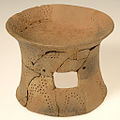Chasséen culture
| Geographical range | Seine-Oise-Marne culture, Véraza culture in southern Languedoc, Treilles culture in the Causses, Ferrières culture in eastern Languedoc, and La Couronne culture ] in Provence |
|---|

Chasséen culture is the name given to the
It covered an area roughly corresponding with the actual French regions of Occitanie and Provence-Alpes-Côte d'Azur. The septentrional Chasséen culture spread throughout the plains and plateaux of France, including the Seine basin and the upper Loire valleys, and extended to the present-day départments of Haute-Saône, Vaucluse, Alpes-de-Haute-Provence, Pas-de-Calais, and Eure-et-Loir. Excavations at Bercy (in Paris) have revealed a Chasséen village (4000 BC - 3800 BC) on the right bank of the Seine; artifacts include wood canoes, pottery, bows and arrows, and wood and stone tools.
Chasséens were sedentary farmers (
By roughly 3500 BC, the Chasséen culture in France gave way to the late Neolithic transitional
Timeline
- 4000: Chasséen village of Bercy near Paris
- 4400: Chasséen village of Saint-Michel du Touch near Toulouse.
- 4400: Appearance of Rössen culture at Baume de Gonvillars in Haute-Saône.
- 3190: Chasséen culture in Calvados.
- 3530: Chasséen culture in Pas-de-Calais.
- 3450: End of Chasséen culture in Eure-et-Loir.
- 3400: End of Chasséen culture in Saint-Mitre (Alpes-de-Haute-Provence).
Genetic profile
An article published in 2020 provided the genetic results of several individuals buried in the Le Crès site (Béziers), ZAC Agora site (Cugnaux), and La Terrasse site (Villeneuve-Tolosane), three males had Y-chromosome haplogroup I2a1a2, where other three males had I1a2b4~, I2 and I2a1b1a2b1a2a2b1b1.[3] From the Champ du Poste necropolis (Carcassonne), three individuals were genetically characterized, and the two Y-chromosome haplogroups found were different: G2a2a1a2a1 and H2m.[4]
Gallery
-
Stone stele
-
Rocher des Doms stele
-
Ceramic
-
Polished stone axes
-
Ceramic jug, 4th millennium BC
Notes
- .
Provence stelae with chevron ornamentation are relatively well dated. They have always been dated to the Middle Neolithic, and more exactly to the Late Chasséen.
- ISBN 978-0-06-250356-5.
The Owl Goddess of western Europe appears in many variations on an unwavering theme; on this stone stele her face is surrounded by a squared-off border of opposed chevrons. Late Neolithic of Provence, Final Chassean culture (Lauris-Purvert, Bouches-de-Rhone, s. France; c. end of 4th mill. BC. H. 30.1 cm
- PMC 7293694.
- PMID 36405775.
See also
- Neolithic France
- Cortaillod culture
- Chasséen-Lagozza-Cortaillod culture
- Rössen culture (4500 BC - 4000 BC)
- Funnelbeaker culture (4000 BC -2700 BC)
- Sepulcres de fossa culture (4200 BC - 3600 BC)
- Véraza culture (3400/3300 BC - 2700/2600 BC)
- Seine-Oise-Marne culture(3100BC - 2000 BC)
- Beaker culture(2800 BC - 1900 BC)





